torque JAGUAR XJ 1994 2.G ZF Automatic Transmission Manual
[x] Cancel search | Manufacturer: JAGUAR, Model Year: 1994, Model line: XJ, Model: JAGUAR XJ 1994 2.GPages: 74, PDF Size: 2.66 MB
Page 42 of 74
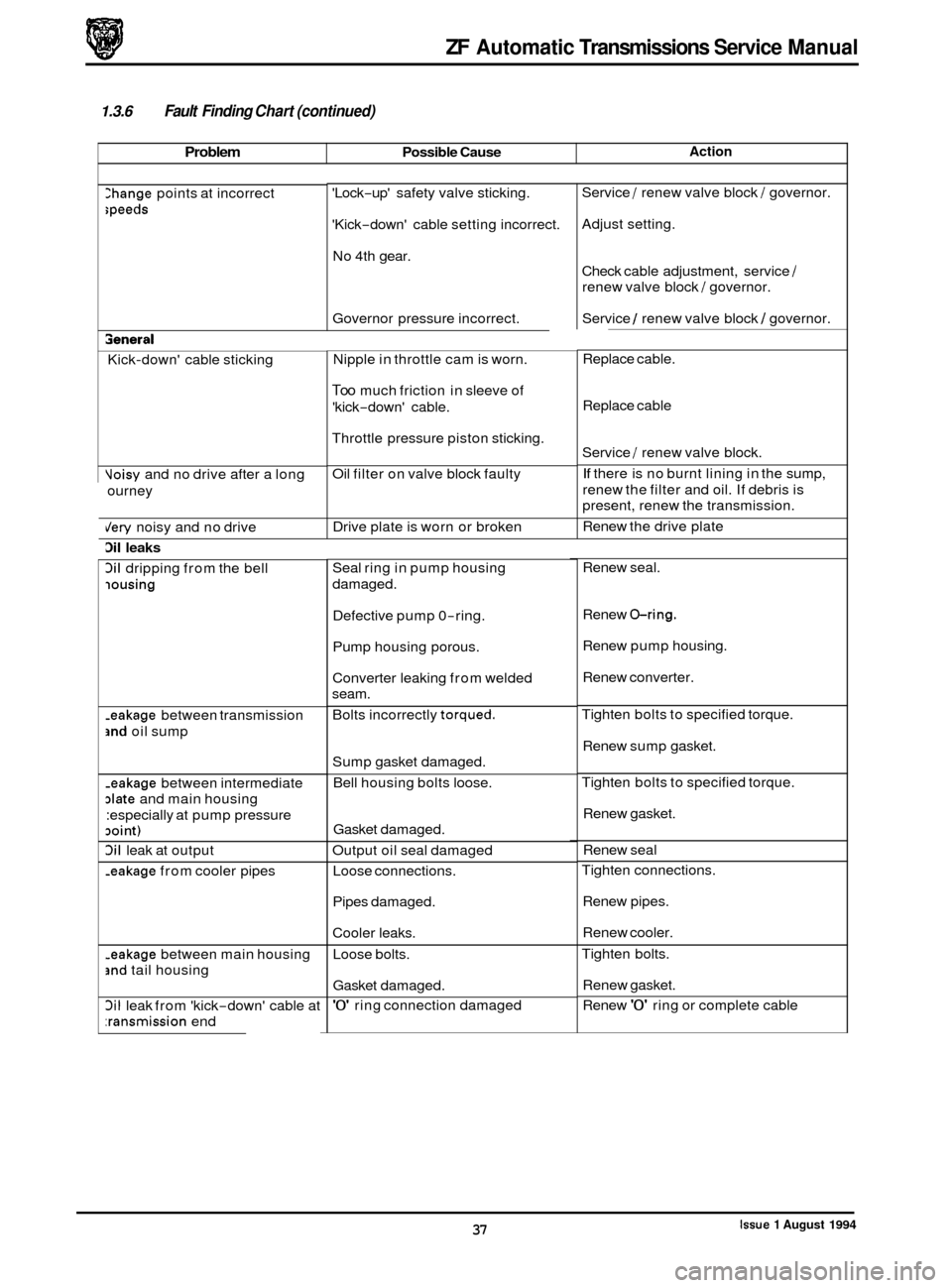
ZF Automatic Transmissions Service Manual
Problem Possible Cause
1.3.6 Fault Finding Chart (continued)
Action
>hange points at incorrect
;peeds
3eneral
Kick-down' cable sticking
Voisy and no drive after a long
ourney
dery noisy and no drive
3il leaks
3il dripping from the bell
iousing
-eakage between transmission
and oil sump
-eakage between intermediate
date and main housing
:especially at pump pressure
Doint)
3il leak at output
-eakage from cooler pipes
-eakage between main housing
jnd tail housing
3il leak from 'kick-down' cable at
:ransmission end 'Lock
-up'
safety valve sticking.
'Kick
-down' cable setting incorrect.
No 4th gear.
Governor pressure incorrect.
Nipple in throttle cam is worn.
Too much friction in sleeve of
'kick
-down' cable.
Throttle pressure piston sticking.
Oil filter on valve block faulty
Drive plate is worn or broken
Seal ring in pump housing
damaged.
Defective pump 0
-ring.
Pump housing porous.
Converter leaking from welded
seam.
Bolts incorrectly
torqued.
Sump gasket damaged.
Bell housing bolts loose.
Gasket damaged.
Output oil seal damaged
Loose connections.
Pipes damaged.
Cooler leaks.
Loose bolts.
Gasket damaged.
'0' ring connection damaged Service
/ renew valve
block / governor.
Adjust setting.
Check cable adjustment, service
/
renew valve block / governor.
Service
1 renew valve block I governor.
Replace cable.
Replace cable
Service
/ renew valve block.
If there is no burnt lining in the sump,
renew the filter and oil. If debris is
present, renew the transmission.
Renew the drive plate
Renew seal.
Renew
@ring.
Renew pump housing.
Renew converter.
Tighten bolts to specified torque.
Renew sump gasket.
Tighten bolts to specified torque.
Renew gasket.
Renew seal
Tighten connections.
Renew pipes.
Renew cooler.
Tighten bolts.
Renew gasket.
Renew
'0' ring or complete cable
issue 1 August 1994 37
Page 43 of 74
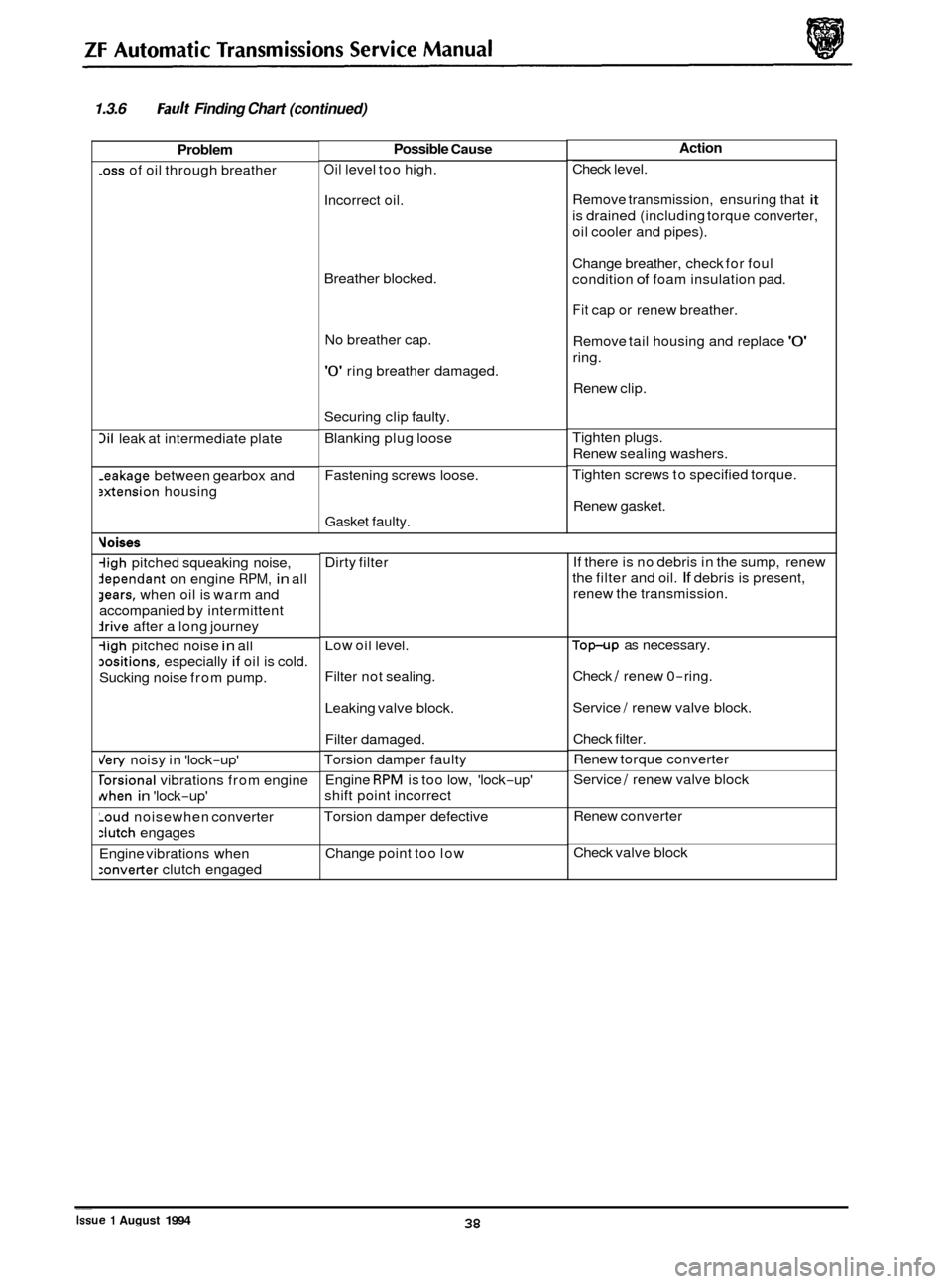
1.3.6 Fault Finding Chart (continued)
Problem
.oss of oil through breather
3il leak at intermediate plate
-eakage between gearbox and
2xtension housing
Uoises
iigh pitched squeaking noise,
jependant on engine RPM, in all
jears, when oil is warm and
accompanied by intermittent
hive after a long journey
iigh pitched noise in all
Dositions, especially if oil is cold.
Sucking noise from pump.
dery noisy in 'lock-up'
rorsional vibrations from engine
Nhen in 'lock-up'
-oud noisewhen converter
:lutch engages
Engine vibrations when
:onverter clutch engaged
Possible Cause
Oil level too high.
Incorrect oil.
Breather blocked.
No breather cap.
'0' ring breather damaged.
Securing clip faulty.
Blanking plug loose
Fastening screws loose.
Gasket faulty.
Dirty filter
Low oil level.
Filter not sealing.
Leaking valve block.
Filter damaged.
Torsion damper faulty
Engine
RPM is too low, 'lock-up'
shift point incorrect
Torsion damper defective
Change point too low
Action ___ Check level.
Remove transmission, ensuring that
it
is drained (including torque converter,
oil cooler and pipes).
Change breather, check for foul
condition
of foam insulation pad.
Fit cap or renew breather.
Remove tail housing and replace
'0'
ring.
Renew clip.
Tighten plugs. Renew sealing washers.
Tighten screws to specified torque.
Renew gasket.
If there is no debris in the sump, renew
the filter and oil.
If debris is present,
renew the transmission.
Top-up as necessary.
Check
I renew 0-ring.
Service
/ renew valve block.
Check filter.
Renew torque converter
Service
I renew valve block
Renew converter
Check valve block ~~
Issue 1 August 1994 38
Page 44 of 74
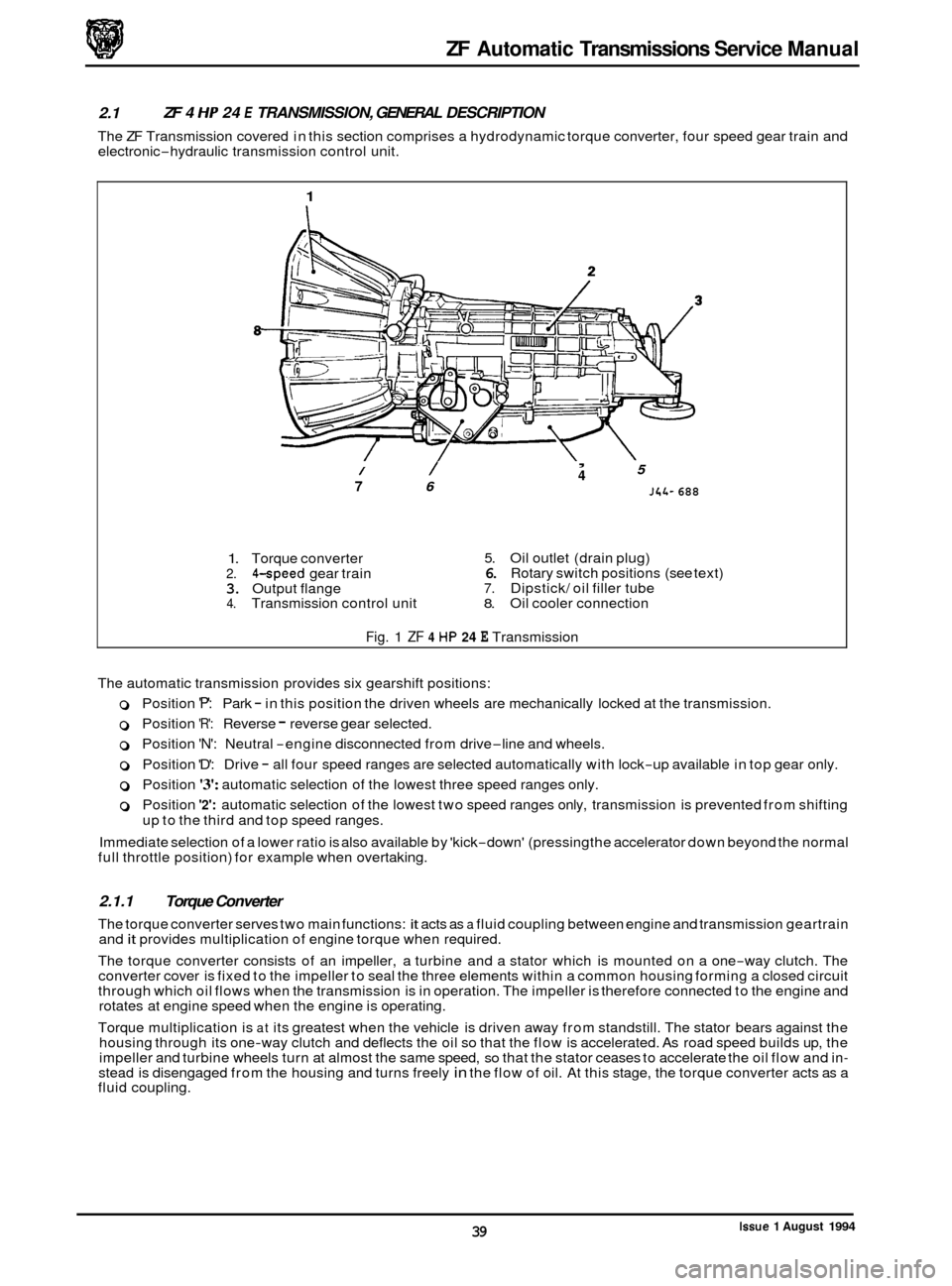
ZF Automatic Transmissions Service Manual
2.1
electronic-hydraulic transmission control unit.
ZF 4 HP 24 E TRANSMISSION, GENERAL DESCRIPTION
The ZF Transmission covered in this section comprises a hydrodynamic torque converter, four speed gear train and
1
/ /
7 6
, 5 4
J4L- 688
1. Torque converter 5. Oil outlet (drain plug)
2. 4-speed gear train 6. Rotary switch positions (see text)
3. Output flange 7. Dipstick/ oil filler tube 4. Transmission control unit 8. Oil cooler connection
Fig. 1 ZF 4 HP 24 E Transmission
The automatic transmission provides six gearshift positions:
0 Position 'P': Park - in this position the driven wheels are mechanically locked at the transmission.
0 Position 'R': Reverse - reverse gear selected.
0 Position 'N': Neutral -engine disconnected from drive-line and wheels.
0 Position 'D': Drive - all four speed ranges are selected automatically with lock-up available in top gear only.
0 Position '3': automatic selection of the lowest three speed ranges only.
0 Position '2': automatic selection of the lowest two speed ranges only, transmission is prevented from shifting
up to the third and top speed ranges.
Immediate selection of a lower ratio is also available by 'kick
-down' (pressing the accelerator down beyond the normal
full throttle position) for example when overtaking.
2.1.1 Torque Converter
The torque converter serves two main functions: it acts as a fluid coupling between engine and transmission geartrain
and it provides multiplication of engine torque when required.
The torque converter consists of an impeller, a turbine and a stator which is mounted on a one
-way clutch. The
converter cover is fixed to the impeller to seal the three elements within a common housing forming a closed circuit
through which oil flows when the transmission is in operation. The impeller is therefore connected to the engine and
rotates at engine speed when the engine is operating.
Torque multiplication is
at its greatest when the vehicle is driven away from standstill. The stator bears against the
housing through its one-way clutch and deflects the oil so that the flow is accelerated. As road speed builds up, the
impeller and turbine wheels turn at almost the same speed, so that the stator ceases to accelerate the oil flow and in- stead is disengaged from the housing and turns freely in the flow of oil. At this stage, the torque converter acts as a
fluid coupling.
Issue 1 August 1994 39
Page 45 of 74
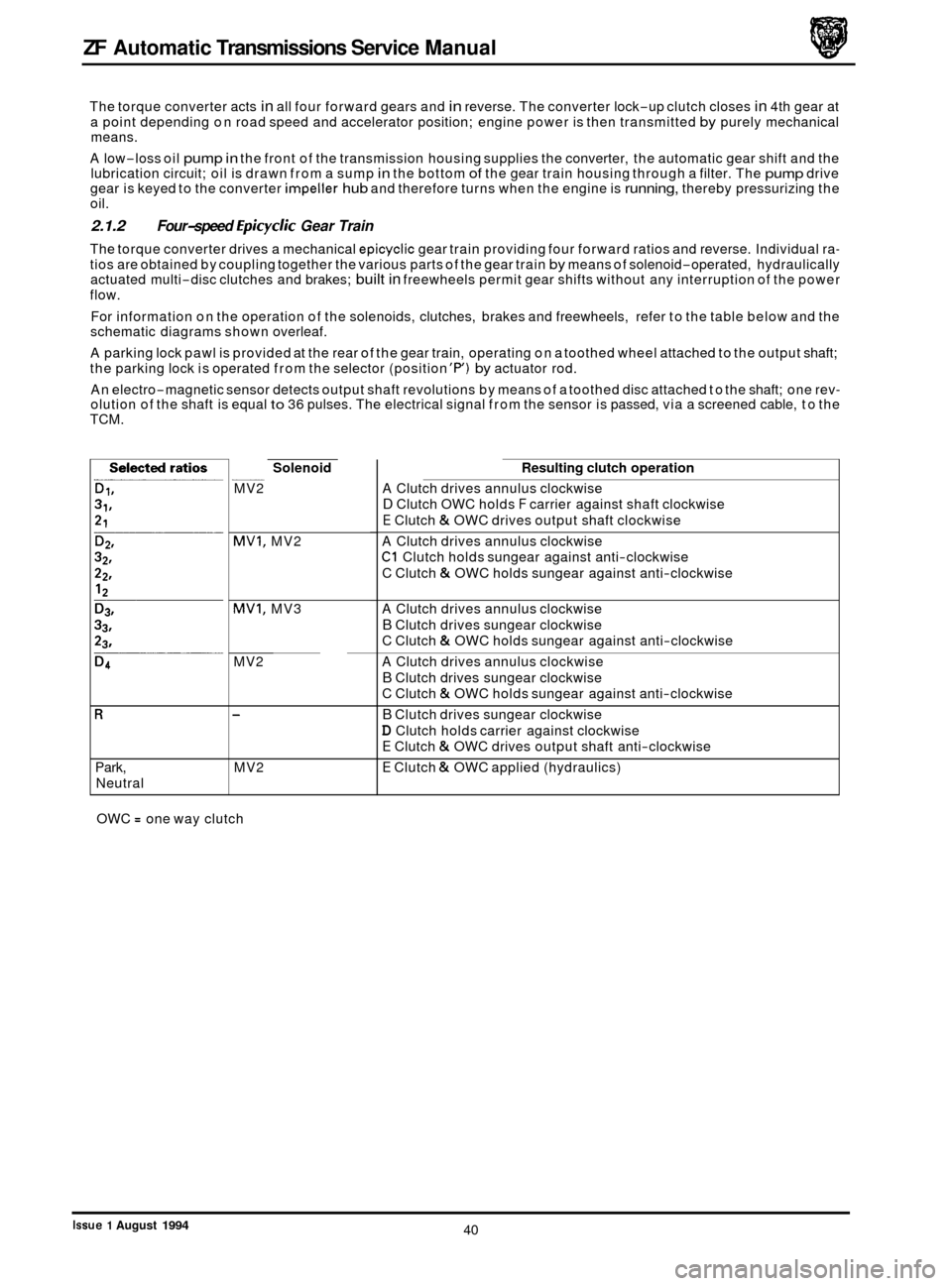
ZF Automatic Transmissions Service Manual
The torque converter acts in all four forward gears and in reverse. The converter lock-up clutch closes in 4th gear at
a point depending on road speed and accelerator position; engine power is then transmitted
by purely mechanical
means.
A low
-loss oil pump in the front of the transmission housing supplies the converter, the automatic gear shift and the
lubrication circuit; oil is drawn from a sump in the bottom of the gear train housing through a filter. The pump drive
gear is keyed to the converter impeller hub and therefore turns when the engine is running, thereby pressurizing the
oil.
2.1.2 Four-speed Epicyclic Gear Train
The torque converter drives a mechanical epicyclic gear train providing four forward ratios and reverse. Individual ra-
tios are obtained by coupling together the various parts of the gear train by means of solenoid-operated, hydraulically
actuated multi-disc clutches and brakes; built in freewheels permit gear shifts without any interruption of the power
flow.
For information on the operation of the solenoids, clutches, brakes and freewheels, refer to the table below and the
schematic diagrams shown overleaf.
A parking lock pawl is provided at the rear of the gear train, operating on a toothed wheel attached to the output shaft;
the parking lock is operated from the selector (position
'P) by actuator rod.
An electro
-magnetic sensor detects output shaft revolutions by means of a toothed disc attached to the shaft; one rev- olution of the shaft is equal to 36 pulses. The electrical signal from the sensor is passed, via a screened cable, to the
TCM.
R
Park,
Neutral
Solenoid ~
MV2
MVI, MV2
MVI, MV3
MV2
-
MV2
OWC
= one way clutch
Resulting clutch operation
A Clutch drives annulus clockwise
D Clutch OWC holds F carrier against shaft clockwise
E Clutch & OWC drives output shaft clockwise
A Clutch drives annulus clockwise
C1 Clutch holds sungear against anti-clockwise
C Clutch
& OWC holds sungear against anti-clockwise
A Clutch drives annulus clockwise
B Clutch drives sungear clockwise
C Clutch
& OWC holds sungear against anti-clockwise
A Clutch drives annulus clockwise
B Clutch drives sungear clockwise
C Clutch
& OWC holds sungear against anti-clockwise
B Clutch drives sungear clockwise
D Clutch holds carrier against clockwise
E Clutch & OWC drives output shaft anti-clockwise
E Clutch & OWC applied (hydraulics)
40
Issue 1 August 1994
Page 46 of 74
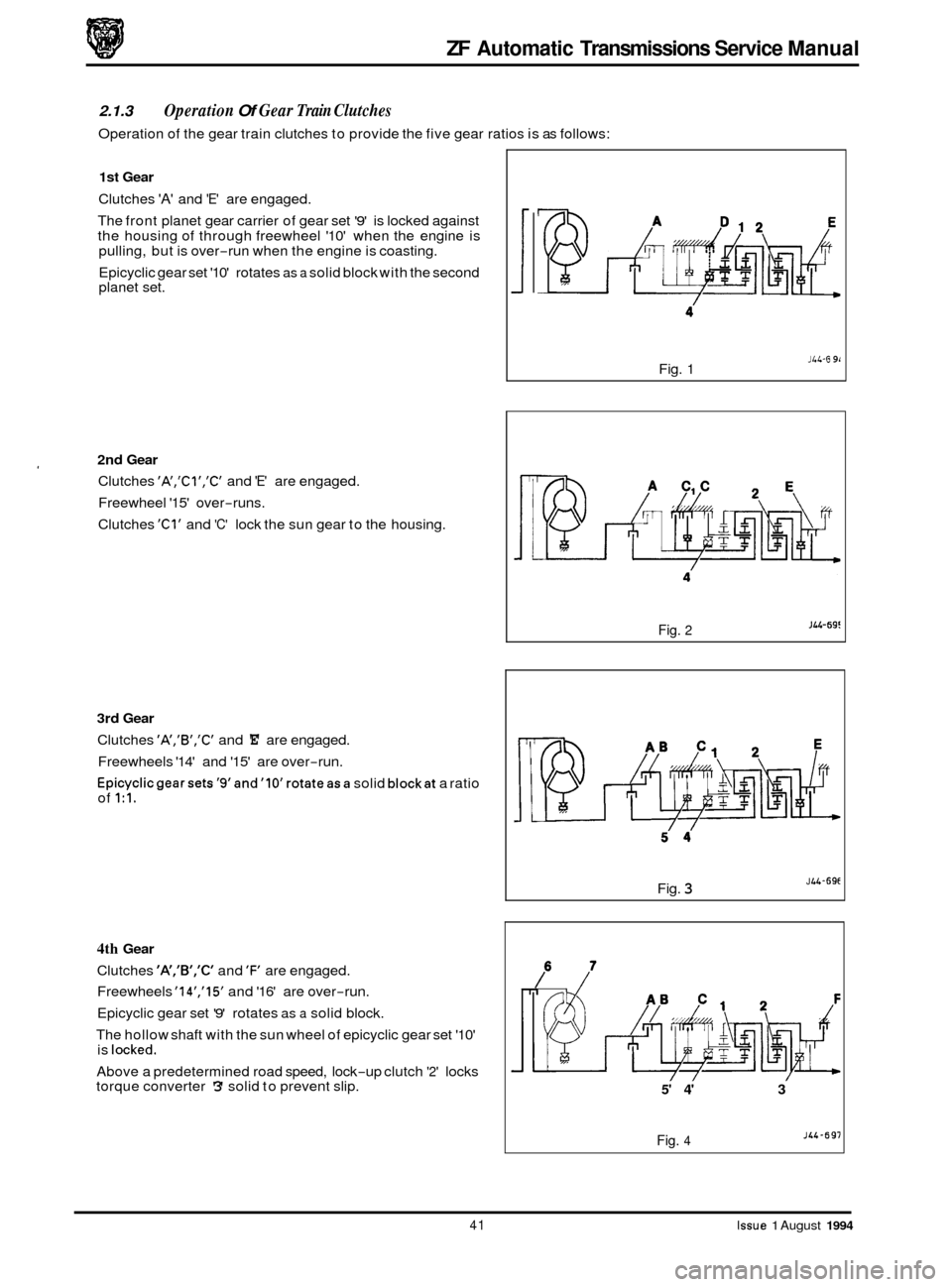
ZF Automatic Transmissions Service Manual
2.1.3 Operation Of Gear Train Clutches
Operation of the gear train clutches to provide the five gear ratios is as follows:
1st Gear
Clutches 'A' and 'E' are engaged.
The front planet gear carrier of gear set
'9' is locked against
the housing of through freewheel '10' when the engine is
pulling, but is over
-run when the engine is coasting.
Epicyclic gear set
'10' rotates as a solid block with the second
planet set.
2nd Gear
Freewheel '15' over-runs.
Clutches
'Cl' and 'C' lock the sun gear to the housing.
* Clutches 'A','Cl','C' and 'E' are engaged.
3rd Gear
Clutches 'A','B','C' and 'E' are engaged.
Freewheels '14' and '15' are over
-run.
Epicyclicgearsets'9'and'lO'rotateasa solid blockat a ratio
of 1:l.
4th Gear
Clutches 'A','B','C' and 'F' are engaged.
Freewheels
'14','15' and '16' are over-run.
Epicyclic gear set
'9' rotates as a solid block.
The hollow shaft with the sun wheel of epicyclic gear set '10'
is
locked.
Above a predetermined road speed, lock-up clutch '2' locks
torque converter '3' solid to prevent slip.
I
J4L-G 9 1 Fig. 1
JLL-69: Fig. 2
J 4L-69E Fig. 3
5' 4' 3
JLL-697 Fig. 4
41 Issue 1 August 1994
Page 48 of 74

ZF Automatic Transmissions Service Manual
2.1.6 Transmission Rotary Switch
This switch is located on a square extension of the transmission selector shaft and is linked to the shift lever via the
selector cable. The switch comprises a selector bar which moves across a series of copper segments located on the
switch quadrant. The copper segments are set out in seven bands, each band providing an electrical output or com
- bination of outputs to the TCM.
The electrical outputs to the TCM are in the form of a three
-digit code which takes up three of the seven bands of the
quadrant; the remaining four bands are used for reverse, ground and start inhibit.
2.1.7 Decoder Module
The decoder module, located on the right hand side of the J-gate assembly, is used to translate the three-digit codes
from the rotary transmission switch into single-line functions to feed the illumination module and to provide the fol-
lowing information:
. Cruise control, ie when cruise control can or cannot be engaged.
. Indication when the vehicle is not in 'P' Park.
. Provide the ECM with a Park/ Neutral signal.
2.1.8 Performance Mode Switch
This switch, located on the shift lever surround, provides two alternative shift patterns:
. 'Normal Mode' -for everyday use,
. 'Sport Mode'- gear changes take place at higher road speeds in order to enhance performance.
Note: Torque converter 'lock-up' occurs in fourth gear in each mode.
2. I. 9 'Kick-down' Mechanism
'Kick-down' is activated by the final travel of the accelerator pedal which contacts a floor-mounted switch located be- hind the pedal. Operation of the switch provides a signal to the TCM that a downward change is required. The switch
is adjustable to ensure that the pedal does not overtravel and stretch the cable.
2.1.10 Reverse Safefy Inhibit
If 'R' Reverse is selected when the vehicle is travelling forwards at more than 5 mile / h, solenoid valve MV2 will be
energised to prevent engagement of reverse gear.
2.1.11 Gearshift hterlock
A brake pedal /gearshift interlock is incorporated in the gear selector mechanism. The gear selector lever may only
be moved from the P - Park position if the ignition key switch is in position II and the foot brake is applied.
The ignition key cannot be removed from the ignition switch unless the shift lever is in
the 'P - Park position. Once
the ignition key has been removed, the shift lever is locked in the park position.
2.1.12 Starter Inhibit Switch
The starter inhibit switch prevents the starter motor from being operated when the shift lever is not in position 'P' - Park or position 'N' - Neutral. The switch is located in the gear selector housing.
issue 1 August 1994 47
Page 52 of 74

4
AFLR M- -1
4 13 9
14
15 7
J44-718
1.
Selector 2. Mode switch 3. Rotary switch
4. Transmission control unit 5. Output shaft speed sensor 6. Kick-down switch 7. Battery
8. Transmission relay
9.
10.
11.
12.
13.
14.
15.
16.
Transmission control module (TCM)
Reverse lamps
Start inhibiter
Engine speed
Ignition retard
Engine load
Engine control module
(ECM) Engine speed sensor
Fig.
1 Control Layout Schematic
2.1.5 Transmission Control Module (TCM)
The Transmission Control Module (TCM) is an electronic control unit located in the front passenger footwell behind
the underscuttle pad. It is electrically connected to the transmission and other components through a cable harness
and multiple pin plug.
The TCM continuously monitors the gear selected (via the rotary transmission switch), the speed of the output shaft
(by speed sensor on the output shaft) and throttle position ('kick
-down' switch). This information plus input from the
Engine Control Module (ECM) of throttle angle and engine speed and load in conjunction with a pre-programmed con- trol map, enables the most suitable gear to be selected.
The TCM, by operating solenoid valves
MVI, MV2 and MV3, controls the gear shift speed and in conjunction with the
solenoid operated pressure control valve, controls the gear shift quality. Gear shift quality on upshifts is improved by
the TCM momentarily retarding the ignition to reduce the torque input as the gear change takes place. Information
is fed to the TCM from sensors and
if any electronic component fails, the basic shift changes will be performed by the
hydro-mechanical system, ie Park, Reverse, Neutral, D3 or D4.
46
Issue 1 August 1994
Page 53 of 74

ZF Automatic Transmissions Service Manual
Vehicle speed sensor plus input
Engine speed input
Program switch input
Solenoid valve
MVI output
Pressure control valve PCV output
?. 1.13 Harness Connections
3&31 not used
32
33 Position code
Z input
38 Torque
reduction
T (I) output
34
-37 not used
Vehicle speed sensor minus input
37
55
not used
\I
41 I Kick down switch input
J" i"
Diagnostic L-line
Transmission malfunction indicator lamp
output
not used
Solenoid valves plus input
Vehicle speed sensor screen
Engine torque signal
T(T) input
I IU,MW II
43 not used
44 Oil temperature sensor ground
45 not used
46
Oil temperature sensor input
47 Throttle position input
48 not used
I
not used
Solenoid valve
MV2 output
not used
Power ground input 19
49 Sport mode indicator output
50 Position code X input
51 Diagnostics K
-line
52
-55 not used
J86 I I69 1
Fig.
1 Transmission Control Module Connections - Pin Locations
I1
12
13
: I
17-18
22
-23
t 27-28
25
26
Function I Pin I Function I
Power supply input I 29 I Program switch /Traction control input I
Digital ground input I 39-40 lnot used I
not used
-~
48 Issue 1 August 1994
Page 56 of 74
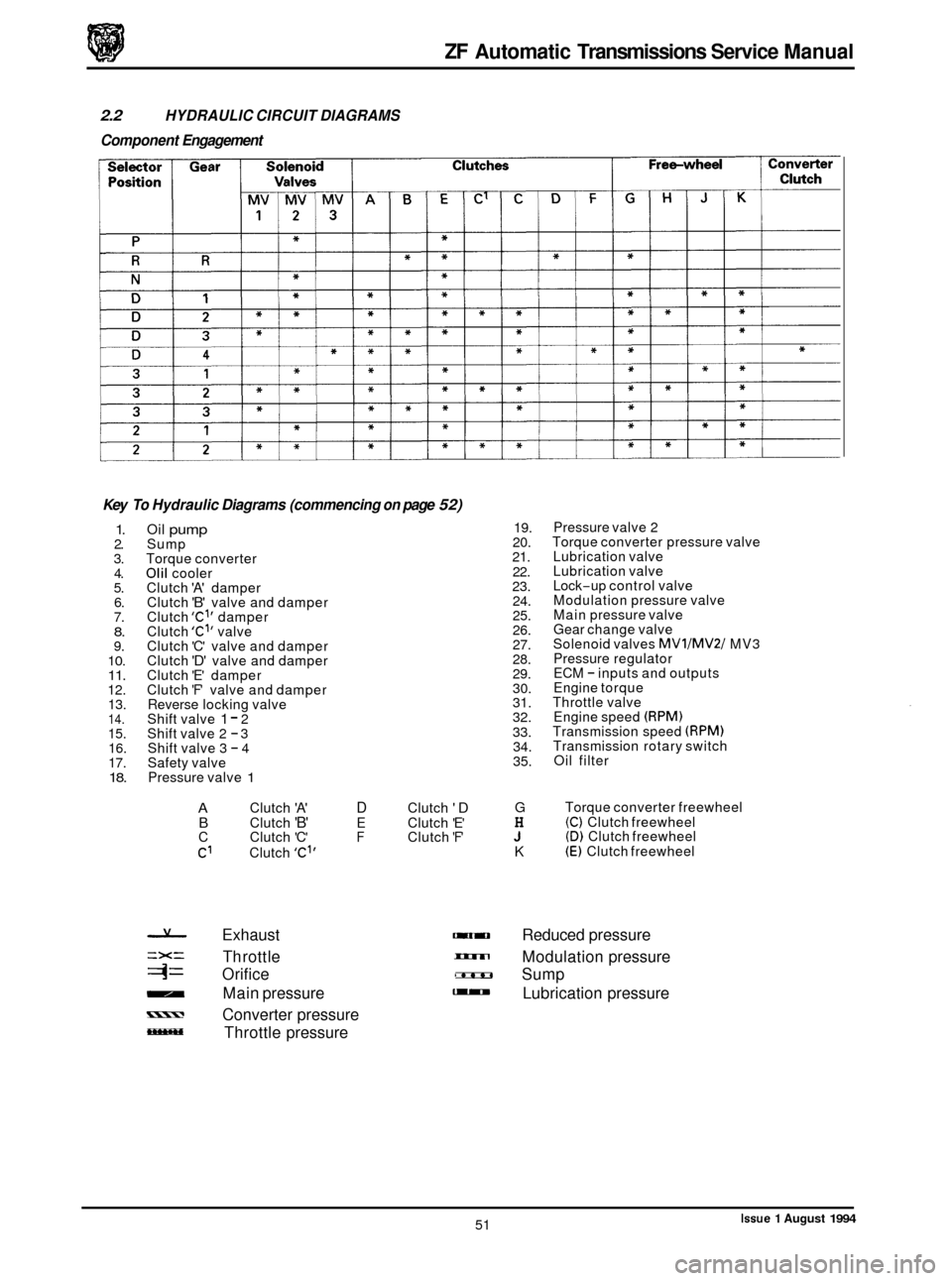
ZF Automatic Transmissions Service Manual
2.2 HYDRAULIC CIRCUIT DIAGRAMS
Component Engagement
Key
To Hydraulic Diagrams (commencing on page 52)
1. 2.
3. 4.
5. 6.
7.
8. 9. 10. 11. 12. 13.
14. 15. 16.
17.
18.
Oil pump Sump
Torque converter
Olil cooler
Clutch 'A' damper
Clutch 'B' valve and damper
Clutch 'Cl' damper
Clutch 'Cl' valve
Clutch 'C' valve and damper
Clutch
'D' valve and damper
Clutch 'E' damper
Clutch
'F' valve and damper
Reverse locking valve
Shift valve
1 - 2
Shift valve 2 - 3
Shift valve 3 - 4
Safety valve
Pressure valve
1
A Clutch 'A' D Clutch 'D B Clutch 'B' E Clutch 'E'
C Clutch 'C' F Clutch 'F'
C1 Clutch 'C"
19.
20.
21.
22.
23. 24.
25.
26.
27.
28.
29.
30.
31.
32.
33. 34.
35.
G
H J K
Pressure valve 2
Torque converter pressure valve
Lubrication valve
Lubrication valve
Lock
-up control valve
Modulation pressure valve
Main pressure valve
Gear change valve
Solenoid valves
MVllMV2l MV3
Pressure regulator
ECM
- inputs and outputs
Engine torque
Throttle valve Engine speed
(RPM) Transmission speed (RPM) Transmission rotary switch
Oil filter
Torque converter freewheel
(C) Clutch freewheel (D) Clutch freewheel (E) Clutch freewheel
Exhaust - Reduced pressure
=X= Th rott le - Modulation pressure
4= Orifice 2- Sump
- Main pressure - Lubrication pressure
- Converter pressure
Throttle pressure
Issue 1 August 1994 51
Page 66 of 74
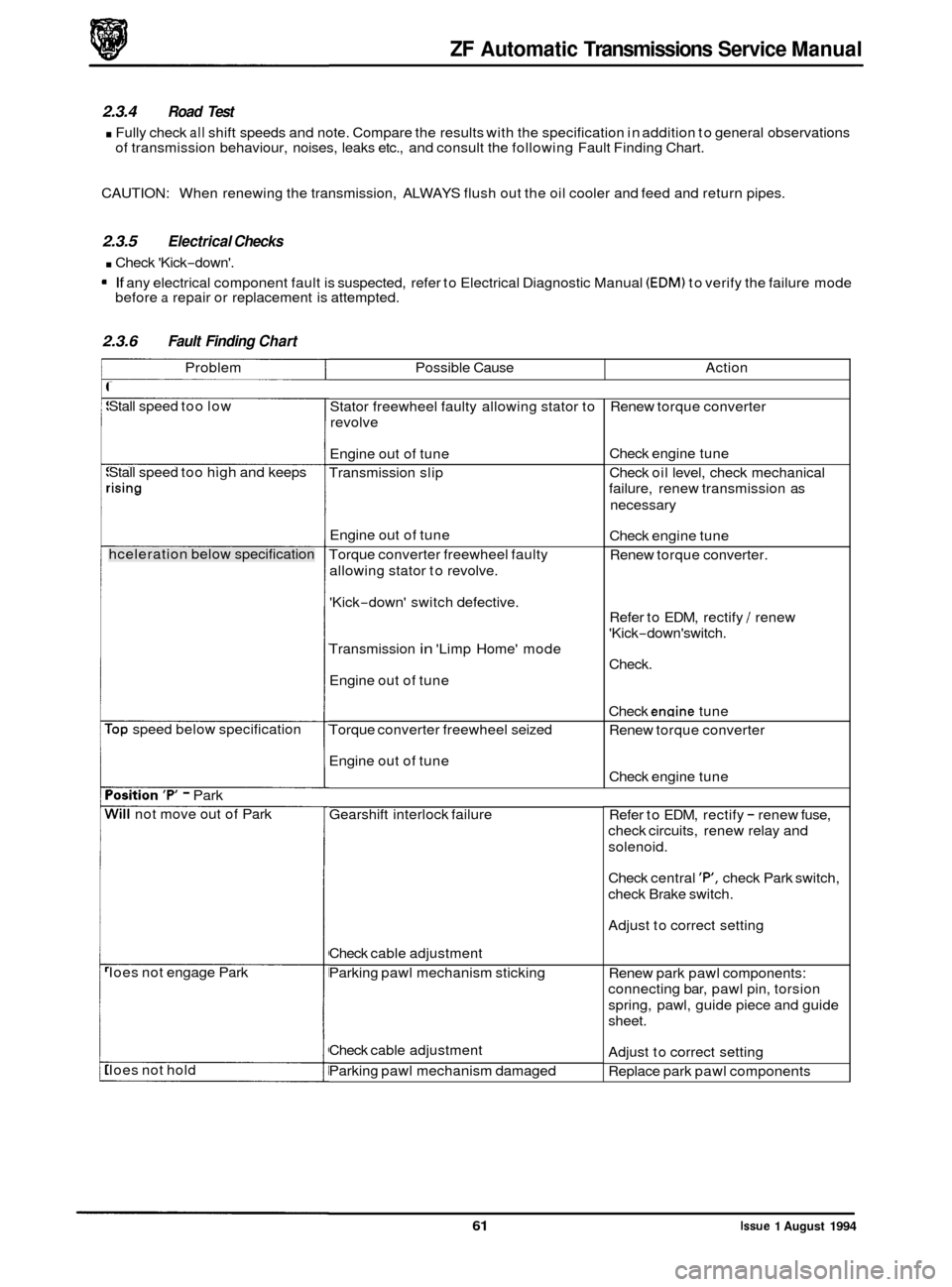
ZF Automatic Transmissions Service Manual
Problem Possible Cause
2.3.4 Road Test
. Fully check all shift speeds and note. Compare the results with the specification in addition to general observations of transmission behaviour, noises, leaks etc., and consult the following Fault Finding Chart.
Action
CAUTION:
When renewing the transmission, ALWAYS flush out the oil cooler and feed and return pipes.
2.3.5 Electrical Checks
. Check 'Kick-down'.
If any electrical component fault is suspected, refer to Electrical Diagnostic Manual (EDM) to verify the failure mode
before a repair or replacement is attempted.
2.3.6 Fault Finding Chart
Stall speed too low
Stall speed too high and keeps
,ising
hceleration below specification
Top speed below specification
'osition 'P - Park
Nil1 not move out of Park
Ioes not engage Park
Ioes not hold Stator
freewheel faulty allowing stator to
revolve
Engine out of tune
Transmission slip
Engine out of tune
Torque converter freewheel faulty
allowing stator to revolve.
'Kick
-down' switch defective.
Transmission
in 'Limp Home' mode
Engine out of tune
Torque converter freewheel seized
Engine out of tune
Gearshift interlock failure
Check cable adjustment
Parking pawl mechanism sticking
Check cable adjustment
Parking pawl mechanism damaged Renew
torque converter
Check engine tune
Check oil level, check mechanical
failure, renew transmission as
necessary
Check engine tune
Renew torque converter.
Refer to EDM, rectify
I renew
'Kick
-down'switch.
Check.
Check
engine tune
Renew torque converter
Check engine tune
Refer to EDM, rectify
- renew fuse,
check circuits, renew relay and
solenoid.
Check central
'P, check Park switch,
check Brake switch.
Adjust to correct setting
Renew park pawl components:
connecting bar, pawl pin, torsion
spring, pawl, guide piece and guide
sheet.
Adjust to correct setting
Replace park pawl components
61 Issue 1 August 1994